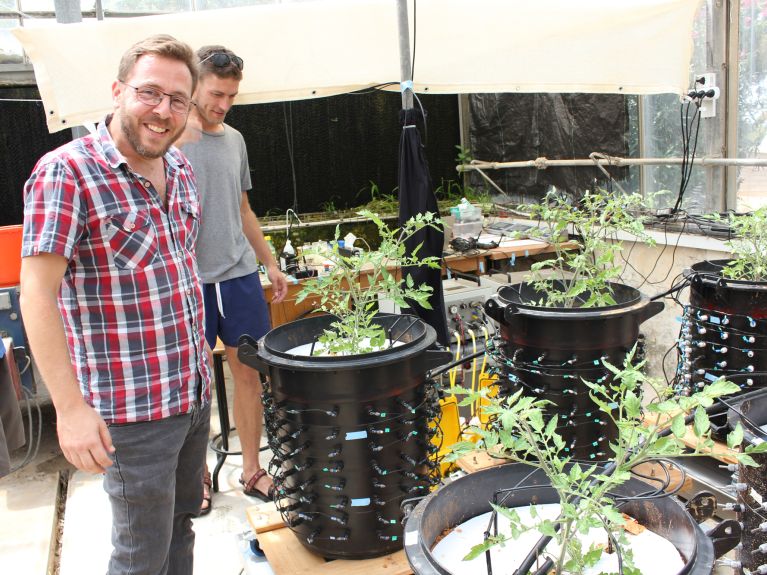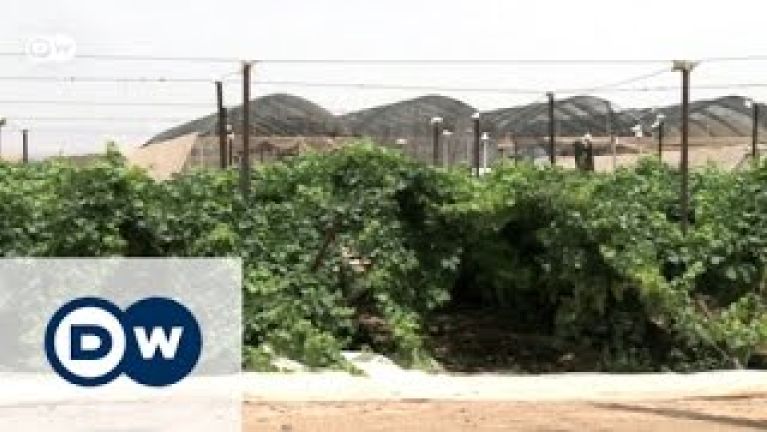The root-researchers
Dealing with drought: Researchers from Israel and Germany are working together to find new opportunities for agriculture.

The contraption rattles and hums at the far end of the greenhouse: Three small tomato plants stand there in large tubs connected by 128 electrodes to suitcase-sized metal boxes. These, in turn, send data to a laptop that stands on a wooden table. What looks like an EEG, a kind of brain scan for plants is, in reality, an ERT, an electrical resistivity tomography. “This allows us to create 3D images of the soil and thus determine where the roots of the plant are picking up water”, explains Nimrod Schwarz, who is bending over one of the pots and surveying the plant.
The 40-year-old soil hydrologist – with his cheerful demeanour, glasses and five o’clock shadow atop a checked shirt – is a researcher at the Faculty of Agriculture, Food and Environment. This forms part of the Hebrew University of Jerusalem but is situated 55 kilometres to the west in Rechovot. Here, Schwarz and his team investigate the behaviour of various different roots in the soil, most significantly when it is very dry and salty. The results should help farmers to find plants with the right kind of root systems for their soils.
Israel as a pioneer in water research
Schwarz is not working alone: Among others, he is collaborating with Andrea Carminati, Professor of Soil Physics at the University of Bayreuth. “There are a lot of Germans involved in my area of research. I met Andrea during my time as a post-doc in Belgium – he was my supervisor,” explains Schwarz, who collaborates with other German researchers too. Israel and Germany have been cooperating in the area of water research for decades. It works well, says Schwarz, since they understand each other, and communication is direct and straightforward. Carminati, who is originally from Italy but has lived in Germany for 12 years, has already been to Israel twice. “The collaboration was very successful there – and that crucially laid the initial foundations,” he explains.
Carminati and Schwarz are carrying out research as part of the German-Israeli Water Technology Cooperation Programme, funded by the German Federal Ministry of Research and Education and by the Israeli Ministry of Science and Technology. Since 1974 there have been more than 150 such German-Israeli projects aimed at finding new ways to deal with water scarcity. “Israel is a pioneer in this area, and it’s there that drip irrigation was invented,” explains Carminati.
“More crop per drop”
This little country has no choice but to be innovative: In summer there is often no rain for months on end, so the soil dries out and there is not enough water for extensive artificial irrigation. Nevertheless, the country has made successful use of technology to further agriculture even in desert regions. The research results are interesting for Germany too, since a drought last year caused some problems for farmers.
In the end, however, it’s not just about benefitting these two participating countries, but about feeding the world’s population. “More crop per drop,” says Schwarz, quoting a United Nations slogan that applies to his research work, too. The problem is that plants leave behind salt, whilst water absorbs it. Soils become ever more saline, which makes water absorption increasingly difficult,” explains Schwarz. The earth, the soil with all its nutrients, is a finite commodity that has developed over centuries and cannot be artificially produced. Compost? “It’s not sufficient for cultivation of the kind of plants that supply carbohydrates and feed us: corn and grains,” Schwarz elaborates.
Behaviour of the M82
One solution might therefore be to cultivate plants that can cope with dry, salty soils. For their experiments, Nimrod Schwarz, Andreas Carminati and their colleagues have planted tomatoes of the M82 variety. “It’s a common variety,” explains Schwarz, but it is being refined in that the tomato itself is being transplanted onto various different root systems. Here, Schwarz and Carminati are working with three different root types.
In the laboratory Carminati is focusing on the processes inside the plants, which are rooted in smaller pots. Right now, he and his team are attempting to find out which processes prompt the plants to close their stomata, i.e. their pores, when there is a drought. It is through these that plants usually absorb carbon dioxide and excrete water and oxygen. When water gets scarce, however, the plants have to save it – and therefore close their stomata. “Knowledge about this can help us, for example, to find suitable irrigation methods.”
Dieses YouTube-Video kann in einem neuen Tab abgespielt werden
YouTube öffnenThird party content
We use YouTube to embed content that may collect data about your activity. Please review the details and accept the service to see this content.
Open consent formSchwarz and his students, meanwhile, are planting the tomatoes in very large pots and also examining the surroundings, i.e. the soil. “Through previous research we have already discovered: The roots mould their physical environment. For example, they release a kind of gel which probably helps with absorption of water.”
In coming months and years, the two researchers will remain in contact via telephone and email – and will also meet in person two or three times a year. The next time will be at the end of September in Dresden, where they will present their project and findings to the two ministries at a conference. To see concrete results, however, we’ll most likely have to wait not months but years.


